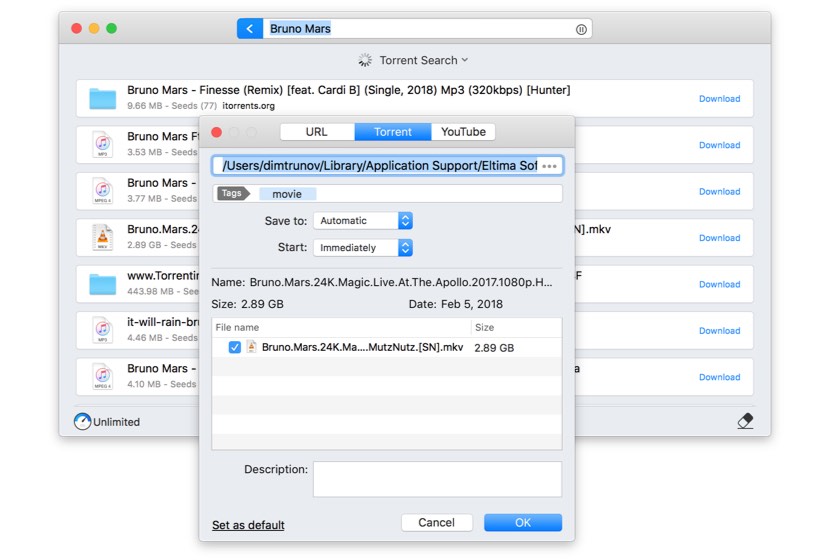

- TRANSMISSION FOR MAC SIERRA HOW TO
- TRANSMISSION FOR MAC SIERRA MAC OS X
- TRANSMISSION FOR MAC SIERRA MAC OS
- TRANSMISSION FOR MAC SIERRA INSTALL
- TRANSMISSION FOR MAC SIERRA SOFTWARE
Note: We may earn a commission when you buy through links on our site, at no extra cost to you. Read definitions of more Apple-related tech terms in our Apple users' tech jargon dictionary. To open the port at system startup use sudo nano /etc/pf.conf and add the sudo pfctl -vnf /etc/pf.conf to this pf.conf file. Follow these steps to open a specific port (in this example 8080) in OS X. Earlier versions of OS X use ipfw, which is now depreciated. In OS X 10.10 you use the pfctl command (use man for instructions). It is possible to open a specific port in OS X, although you'll need to jump into Terminal.
TRANSMISSION FOR MAC SIERRA HOW TO
How to open a specific port in OS X firewall However, some advanced users-such as web developers or system admins-have a legitimate need to open a specific port. Most users using the default OS X firewall should use this method to Allow and Block incoming connections, rather than manually opening ports. OS X manually manages the ports requested by the app and opens them correspondingly.
TRANSMISSION FOR MAC SIERRA INSTALL
If you have the OS X firewall enabled, you may install a new app that requires you to allow it access through the firewall.

How to open an application's port in OS X firewall We think this is a little "tin-foil hat" for most users. You Mac will no longer respond to ping requests. This prevents other people (or computers on a local network) from discovering your Mac. If an application has a valid certificate the firewall allows incoming connections.

TRANSMISSION FOR MAC SIERRA SOFTWARE
Automatically allow signed software to receive incoming connections.Note this doesn't apply to outgoing connections. The main window displays a list of Applications with the status Allow Incoming Connections or Block Incoming Connections. If you select this checkbox other apps that rely on internet services, such as Dropbox, will stop working. This blocks everything except basic Internet services, such as DHCP, Bonjour, and IPSec. The Security & Privacy window displays a window with a selection of options: Open System Preferences (Apple menu > System Preferences).Follow these settings to access the Firewall Options: In either case a hardware firewall is provided, typically as part of NAT (Network Address Translation).Īnother oddity is that OS X firewall doesn't manage ports individually, but on a per-application basis. However, most computers no longer connect directly to the internet via a DSL modem, instead most go through a router provided by their Internet Service Provider (or via a corporate network). This might strike you as odd, because Apple is so keen on security. The firewall in OS X is turned off by default. Using OS X firewall to block and open Ports OS X firewall only allows access to specific areas. With the firewall turned off every application has access to every area. Think of your Mac's IP address (used to connect it to the network) as a hotel, ports as room numbers and applications as guests. Ports are the specific connections between your Mac and the network, and a firewall sits between your Mac and the network and decides which port is open and which is closed. It might help to clear up the concept of ports and firewalls.
TRANSMISSION FOR MAC SIERRA MAC OS
Terminal tips and tricks: 10 terminal projects How does the firewall work in Mac OS X? How to network Macs and share files between Macs over the network
TRANSMISSION FOR MAC SIERRA MAC OS X
How to use System Preferences in Mac OS X Yosemite This used to be done using ipfw, but in OS X 10.10 and later you use a new command: pfctl. You can allow or block incoming traffic to specific apps using the Security settings, but you can open specific ports in terminal. OS X manages the firewall on a per-application basis, but sometimes you want to open a specific port on your Mac. The firewall sits between OS X and the internet and only allows incoming traffic to come through on specific ports. Mac OS X comes with a built-in firewall service that can be used to protect your Mac from online security risks.


 0 kommentar(er)
0 kommentar(er)
